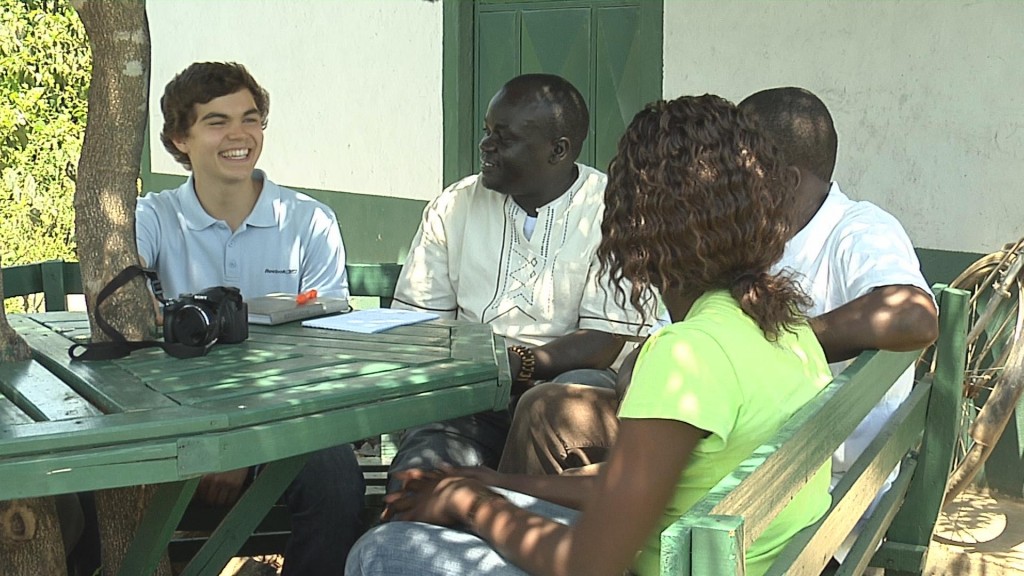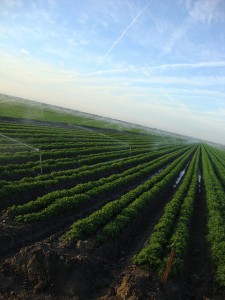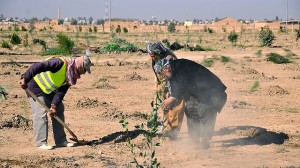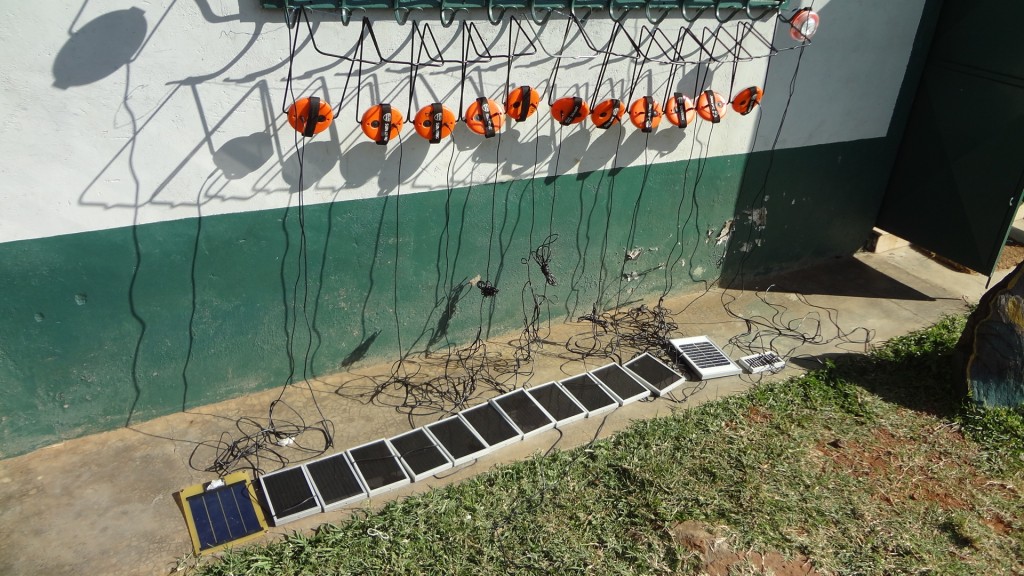“Green” Light for Lake Victoria
“Take a gap year and save the planet!” This could be the motto of the Kenyan based organisation “Ecofinder”. Founded in 1995 the Kenyan grass roots organisation helps communities around Lake Victoria to lead a more sustainable life. GLOBAL IDEAS has invited one of Ecofinder’s numerous volunteers to write about his experience:
A lot of people especially in developing countries have no acess to electricity. That’s why most of them use kerosene lamps for at least a little bit light at night. But this is quite dangerous because of the open fire and it’s unhealthy for the people because of the smoke. Therefore Ecofinder started a very interesting project, the “Solar Lamps Rentals”, in March 2012.
The project’s idea and structure is quite simple but very efficient:
After a training about small-scale business and solar lamps, Ecofinder provides a new “Solar Lamps Entrepreneur” with a starter pack of 10 solar lamps. Now he can rent them every night to his local customers and charge them during the daytime. The only condition is that he will pay back 25% of his income to Ecofinder until the lamps are paid off and that the price for the lamps a night is below the local common price for kerosene lamps.
With the earned money Ecofinder is able to spread the solar lamps project and to buy new lamps for new entrepreneurs. One of my first tasks was to put the repayment’s bookkeeping in order and to assign it to an excel-softcopy. After this office work I could visit and meet all our eight “Solar Lamps Entrepreneurs”. I asked them about their running business, problems, wishes and how much solar lamps they would need more to provide the demand of all customers. The response on the last question was clearly. The market for affordable solar lamps is huge. It’s environmental friendly and you can even earn your own money with the rentals. A perfect project combination of ecological and economic aspects.
But you can imagine, it is’nt everyhing perfect from the very beginning. We have also some problems, more information the next time.
Urban paradise under threat
Germany’s most famous urban garden is attracting hundreds of visitors each week. The farmers from the “Prinzessinnengarten” fear that the city of Berlin might be selling their plot soon. This would be the end of an exceptional ecological urban project.
In our GLOBAL IDEAS audio-slideshow founder Marco Clausen shows us around the Prinzessinnengarten:
Gardening goes guerilla in Berlin from DW_Global Ideas on Vimeo.
Money versus Vegetables
At the moment it is highly unsure, if the success story of the Prinzessinnengarten is going to be still around in 2014. The garden’s rental contract ends at the end of 2013. A spokesperson of the Berlin city council (“Senatsverwaltung für Finanzen”) told GLOBAL IDEAS that negotiations for a new contract are currently “ongoing”.
But the urban farmers are fearing that the city of Berlin will be selling off their plot to the most bidding party rather than setting up a new contract with them. Since new stores, an office space for freelancers and artists and a hotel chain have settled close to the Prinzessinnengarten, the area around Kreuzberg’s Moritzplatz got more and more popular with property prices rising. According to a spokesperson of the city’s own Property Fund, negotiations with investors looking at buying the formerly vacant plot have already been made.
Whilst the council of Friedrichshain-Kreuzberg, the communal political body, promised to be supportive of the project trying to help conserve it, the final decision lies in the hands of the city of Berlin. At the end of the day it will be mayor Klaus Wowereit and his government who will have to decide about the Prinzessinnengarten’s future.
Let it grow!
To stop the sell-out of the Prinzessinnengarten, Marco and his co-founders started the campaign “Let it grow”. In an open letter to the city of Berlin they are demanding to prolong the rental contract for another five years. If the city does not agree, Marco and his team will have to leave the plot at the end of next year.
You can sign the open letter to the Berlin senate on the homepage of the Prinzessinnengarten.
Kenyan Volunteers save the planet
“Take a gap year and save the planet!” This could be the motto of the Kenyan based organisation “Ecofinder”. Founded in 1995 the Kenyan grass roots organisation helps communities around Lake Victoria to lead a more sustainable life. GLOBAL IDEAS has invited one of Ecofinder’s numerous volunteers to write about his experience:

Hello, my name is Nicolas Kawerau from Germany. Currently I live in Kisumu, Kenya where I work as a volunteer with the Kenyan organisation Ecofinder for one year. I am 18 years old and have done my A-Levels this year. I know already what I would like to study: “Renewable Energy Technologies”.
To live and behave sustainable on our earth is a big challenge. You can hear the expression “Sustainability” everywhere. Everyone says it is essential and very important for our future – but the problem is you can hardly see sustainable measures anywhere: We pollute the air, we pollute the soil, we pollute the water with our waste, we destroy the world’s surface.
Everyone can start saving the planet now
It’s fine that a lot of people know already about these issues but most people don’t change their behaviour. They think it wouldn’t have an impact. It’s true that no one alone can change the world. But it’s false to believe that a single environmental friendly contribution would be nothing, every little contribution is important.
I am a volunteer for Ecofinder Kenya because I want to start giving our world community a sustainable contribution towards a greener environment. One of my tasks here in Kenya will be to help that electricity only comes from renewable energy sources. The sun provides enough energy, we don’t have to take non-renewable resources like coal, oil, gas or radioactive stuff from the earth for generating power.
Think about your conribution towards a greener environment and try to start as fast as you can! With Ecofinder I will join in and start projects about the spread of renewabel energy sources.
For more information on how to become an Ecofinder volunteer yourself visit the organisation’s homepage: http://www.ecofinderkenya.org
Is the ice-free north-pole just a matter of short-time?

Within this year’s summer period the arctic sea ice shield at the north pole melted dramatically to a new all-time low. The ice mass has fallen short of the record of 2007. And the low could get even lower, because the 2007 record was measured at 18 September. This year we saw the same record already in August. The ice usually melts until the mid of September and then starts again to grow during the winter period. But due to the large melting the new ice will be much thinner than usual. Scientists of the National Snow and Data Center explain that where have been an ice shield of a 3-4 meters just a few years ago, it’s possible to reach only 1-2 meters today. An ice free noth-pole could be the result, they say, followed by the irreversibility of the melting process. According to the Arctic Sea Ice Blog it’s just a question of when until we will see an ice free north pole.If you want to stay updated on that issue, there are lot’s of impressive and in somehow frightening opportunities. The picture on top of this post is provided by the Instituts for Arctic Climate Research at the University of Illinois. It’s going to be updated every day. So it will be possible to see the day the ice will be growing again. The website also offers a 30-day summary of the ice developement. You will also find tons of data about the planet’s ice shield’s via the National Snow and Ice Data Center.
But whats so bad about melting ice? Well, as Global Ideas Climate Expert Anders Levermann explained in one of his videos the arctic sea ice belongs to the earth’s tipping points. If the ice melts the dark ocean underneath will heat up and slowly melts even more ice. Here’s the video for you to see:
Eat OR drink?

CC BY 2.0 Julie Jordan Scott/flickr.com
Every human being needs to eat and drink. But in an increasingly crowded world these two basic needs get into conflict: Many people already don’t have access to clean drinking water and/or not enough food. At the same time, agriculture accounts for 70 percent of global water use.
Even worse, diets typical of Western industrialized countries are becoming a blueprint for eating habits around the globe – about 3.000 kcal per day with meat accounting for about a fifth of it. That has dire consequences for the global water household, as producing one kilogram of meat requires the amount of water, an average household uses in 10 months (50 L/person/day).
But to feed every one out of the ten billion people expected to inhabit the globe by 2050, 50 percent more water than now is needed. Water, that is not available for drinking anymore. In the future, will people have to choose whether to eat or to drink?
Scientists are still hopeful: If the amount of food wasted – during harvest, in storage, transport and in households – was cut by half, enough water would be available again – even to produce the required additional amounts of food.
So the solution to future food- and water-shortages is something we already know today: Waste less food, eat less meat.

CC BY 2.0 EarthDayPictures/flickr.com









Feedback